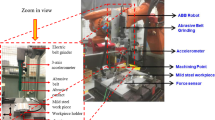Abstract
Hybrid structures of metals and composite materials are increasingly common in aerospace industry, and the optimization and monitoring of the machining of these stacks are an area of active research. Online tool condition monitoring in particular is a valuable capability and is facilitated by real-time treatment of cutting force signals. Cutting force signals are considered one of the most important measures for tool condition monitoring. The present work treats online cutting force time series with fractal analysis. The signal features generated are central to tool wear assessment. This work evaluates the fractal dimension of the cutting force signals from orbital drilling of a stack of carbon fiber–reinforced plastics (CFRP) and Ti6Al4V titanium alloy as a measure of the “roughness” of these signals. It is shown that distinct wear stages are adequately identified using fractal signal features. Low machining quality may thereby be prevented. Additionally, to address the inconvenient need for long machining tests when studying the application of these techniques to CFRP and titanium alloys, a novel fractal index is proposed to improve the monitoring process without requiring extensive experimentation.

















Similar content being viewed by others
References
Pecat O and Brinksmeier E (2014) Tool wear analyses in low frequency vibration assisted drilling of CFRP/Ti6Al4V stack material, in 6th CIRP International Conference on High Performance Cutting, HPC: California, USA p 142-147
Sha W and Malinov S (2009) Titanium alloys : modelling of microstructure, properties and applications.
Xu J, El Mansori M (2016) Numerical studies of frictional responses when cutting hybrid CFRP/Ti composite. Int J Adv Manuf Technol 87(1–4):657–675
Pramanik A, Littlefair G (2014) Developments in machining of stacked materials made of CFRP and titanium/aluminum alloys. Mach Sci Technol 18(4):485–508
Rimpault X et al (2016) Fractal analysis of cutting force and acoustic emission signals during CFRP machining. Procedia CIRP 46:143–146
Hidayah MTN et al (2015) A review of utilisation of cutting force analysis in cutting tool condition monitoring. Int J Eng Technol IJET-IJENS 15(03)
Jantunen E (2002) A summary of methods applied to tool condition monitoring in drilling. Int J Mach Tool Manu 42(9):997–1010
Cheng K (2009) Machining dynamics, fundamentals, applications and practices: Brunel University, Middlesex
Kious M et al (2008) Influence of machining cycle of horizontal milling on the quality of cutting force measurement for the cutting tool wear monitoring. Prod Eng 2(4):443–449
Fang Q et al (2015) A force sensorless method for CFRP/Ti stack interface detection during robotic orbital drilling operations. Math Probl Eng 2015:1–11
Wang H et al (2011) Prediction of cutting forces in helical milling process. Int J Adv Manuf Technol 58(9–12):849–859
Caggiano A et al (2018) Machine learning approach based on fractal analysis for optimal tool life exploitation in CFRP composite drilling for aeronautical assembly. CIRP Ann 67(1):483–486
Rimpault X et al (2018) Online monitoring and failure detection of capacitive displacement sensor in a Capball device using fractal analysis. Measurement 118:23–28
Lachaud L et al (2001) Drilling of composite structures. Compos Struct 52(3–4):511–516
Wang X et al (2014) Comparative tool wear study based on drilling experiments on CFRP/Ti stack and its individual layers. Wear 317:265–276
Mandelbrot BB (1982) The fractal geometry of nature. W.H. Freeman, New York
Feng Z, Zuo MJ, Chu F (2010) Application of regularization dimension to gear damage assessment. Mech Syst Signal Process 24(4):1081–1098
Rimpault X et al (2017) Burr height monitoring while drilling CFRP/titanium/aluminium stacks. Mech Ind 18(1):114
Rimpault X et al (2017) Tool wear and surface quality assessment of CFRP trimming using fractal analyses of the cutting force signals. CIRP J Manuf Sci Technol 16:72–80
Rimpault X, et al. (2016) Fractal analysis of cutting force and acoustic emission signals during CFRP machining, in 7th HPC 2016 – CIRP conference on high performance cutting: Chemnitz, Germany
Kalpakjian S and Schmid S (2014) Manufacturing engineering and technology. 7th, Pearson: Upper Saddle River
Author information
Authors and Affiliations
Corresponding author
Additional information
Publisher’s note
Springer Nature remains neutral with regard to jurisdictional claims in published maps and institutional affiliations.
Rights and permissions
About this article
Cite this article
Jamshidi, M., Rimpault, X., Balazinski, M. et al. Fractal analysis implementation for tool wear monitoring based on cutting force signals during CFRP/titanium stack machining. Int J Adv Manuf Technol 106, 3859–3868 (2020). https://doi.org/10.1007/s00170-019-04880-y
Received:
Accepted:
Published:
Issue Date:
DOI: https://doi.org/10.1007/s00170-019-04880-y




